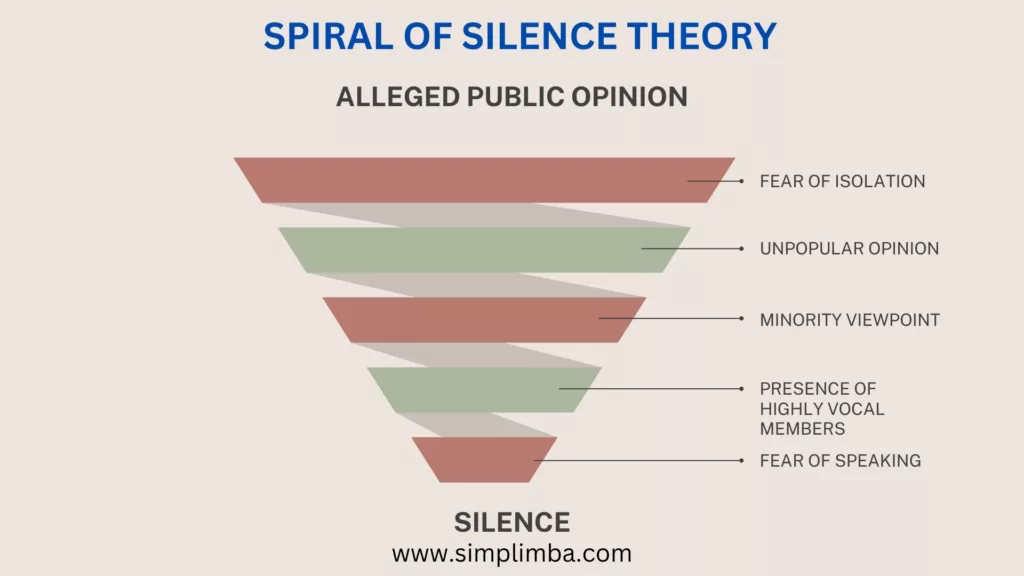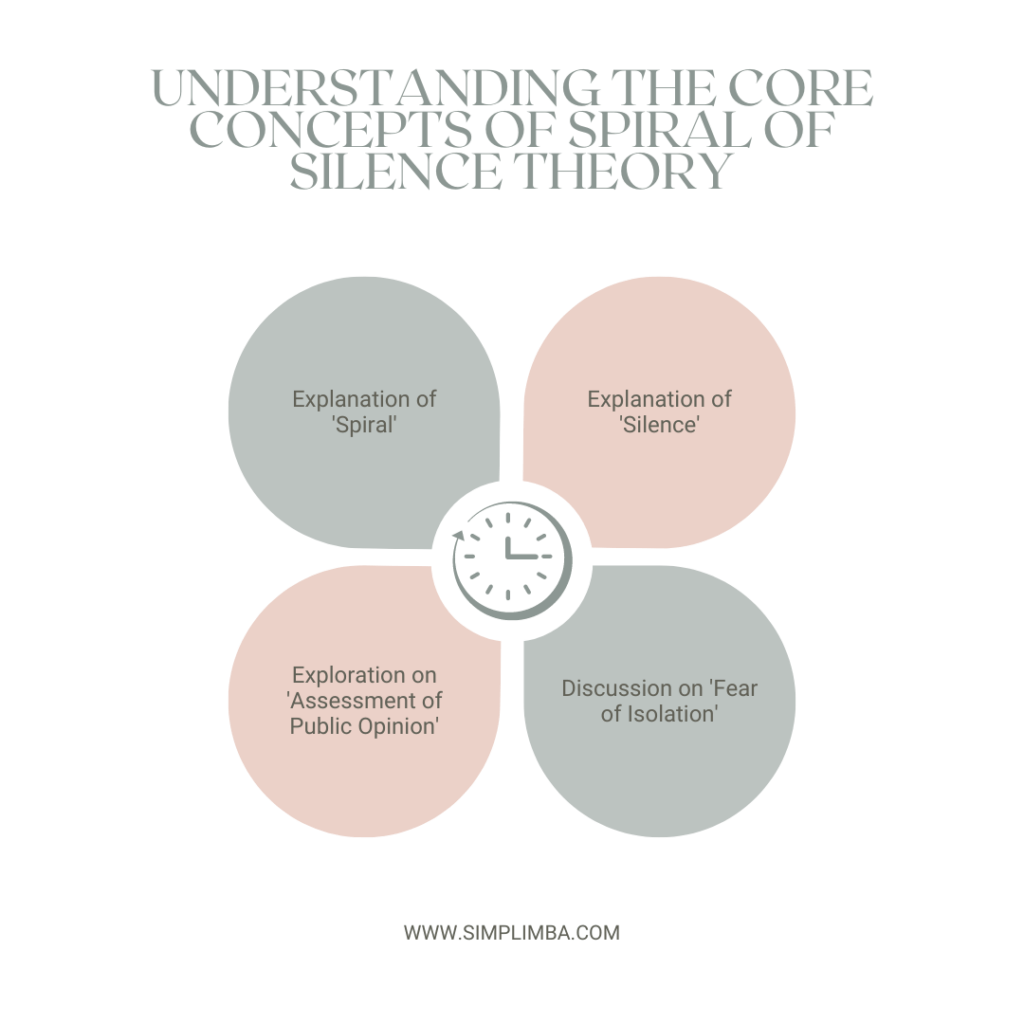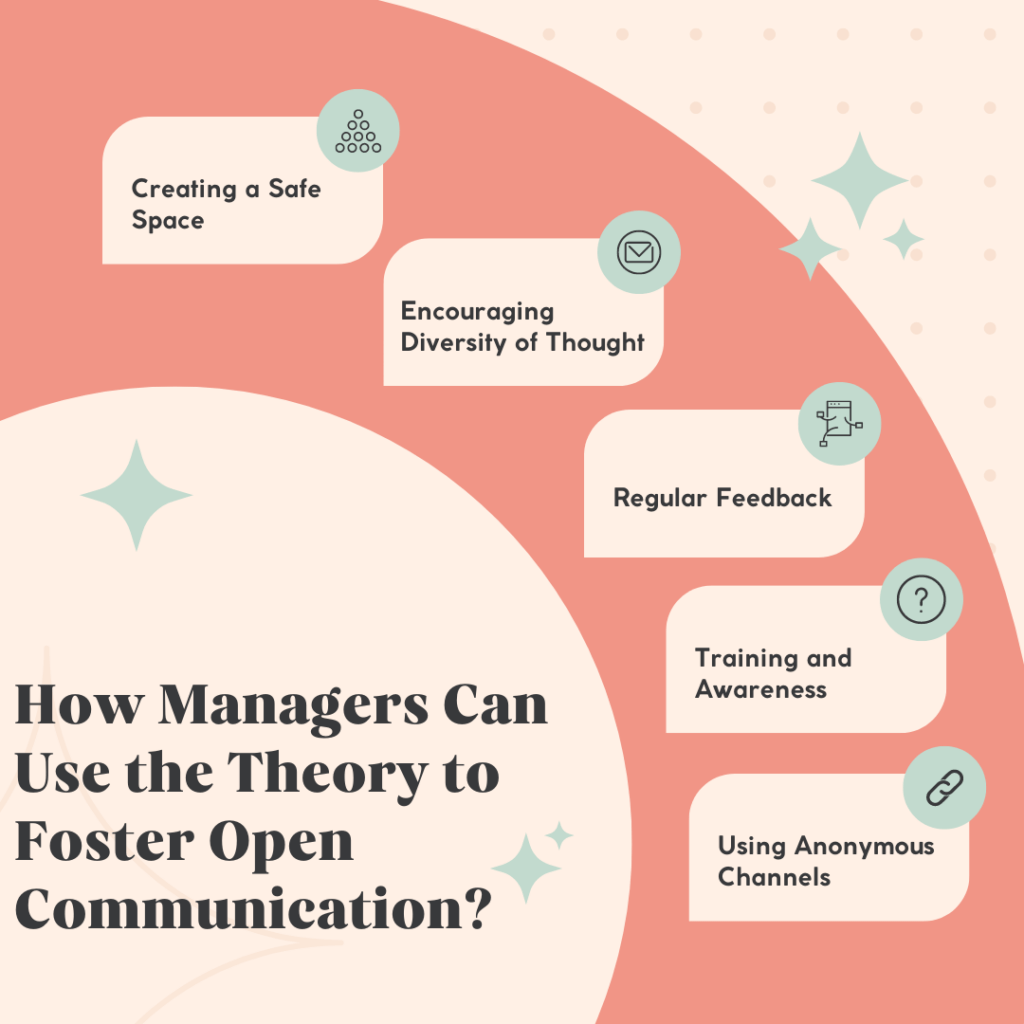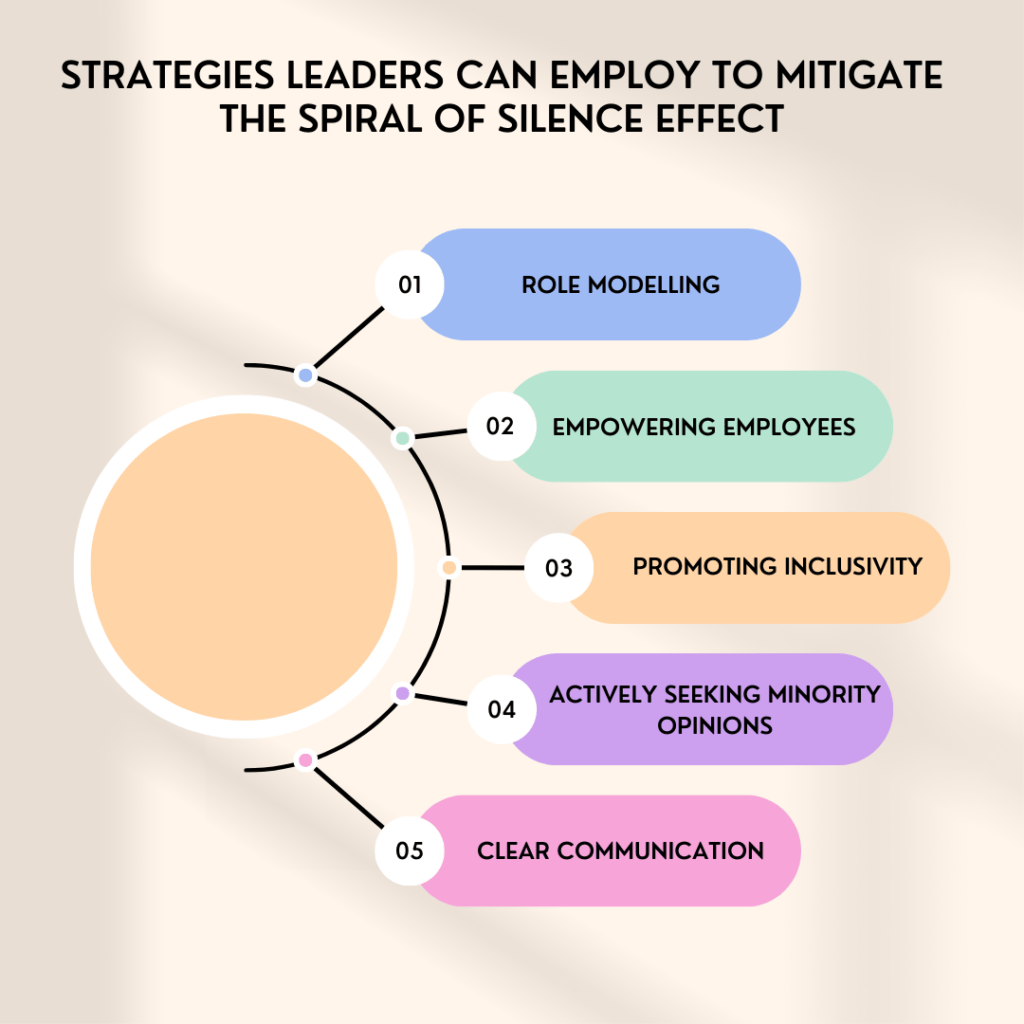A brief overview of the Spiral of Silence Theory

The Spiral of Silence Theory was first introduced by German political scientist Elisabeth Noelle-Neumann in 1974. The theory is grounded in the idea that individuals have a fear of social isolation, which subsequently shapes their willingness to express their opinions in public. According to this theory, individuals constantly gauge the climate of public opinion, and if they perceive their viewpoint to be in the minority, they are less likely to voice their opinion due to the fear of being isolated from society. This perpetuates a spiralling process in which minority opinions are increasingly silenced, while majority opinions gain more visibility and perceived popularity.
In the context of social psychology, the Spiral of Silence Theory is positioned within a broader understanding of how societal norms and perceived public opinion can influence individual behavior. It draws upon concepts such as conformity, social pressures, and the role of mass media in shaping public opinion.
Importance of understanding the theory in mass communication
The Spiral of Silence Theory plays a crucial role in mass communication and is particularly relevant in the era of digital communication platforms. The theory can offer significant insights into how public opinion is shaped and how it evolves.
In the field of mass communication, the theory can be used to examine how media portrayals influence perceived public opinion and individual willingness to express their viewpoints. It can provide a framework for understanding the dynamics of public discourse and the power relations inherent in the communication process.
Understanding the Spiral of Silence Theory can also help communication professionals design better strategies for fostering open and inclusive public debates. By recognizing the factors that lead to the silencing of minority opinions, communicators can work towards creating environments that encourage diverse voices and opinions.
In the digital age where social media platforms have become key players in shaping public discourse, understanding the Spiral of Silence Theory becomes even more critical. The theory can be used to explore how online environments influence the perception of public opinion and the willingness of individuals to express their opinions. This has significant implications for issues such as the spread of misinformation, online polarization, and the digital divide.
Elaboration on the theorist: Elisabeth Noelle-Neumann and Spiral of Silence Theory
Elisabeth Noelle-Neumann, a German political scientist, public opinion researcher, and journalist is the theorist behind the Spiral of Silence theory. Born on December 19, 1916, in Berlin, she is renowned for her vast contributions in the field of communication studies, particularly within the sphere of public opinion.
Noelle-Neumann’s academic journey began at the University of Berlin, where she studied Philosophy, History, Journalism, and American Studies. Her thirst for knowledge and commitment to her studies led her to acquire a doctorate in Philosophy and a post-doctoral lecturing qualification in Journalism and Mass Communication.
Noelle-Neumann served as a newspaper correspondent during World War II and later, in 1947, she founded the public opinion research company, “Institut für Demoskopie Allensbach”, which remains one of the most respected polling institutes in Germany. Her professional experience and insights from practical work in public opinion research significantly influenced her academic research, culminating in the formulation of the Spiral of Silence theory.
Her theory of the Spiral of Silence, published in 1974, is based on her meticulous observation of German society’s behavior over time. The theory proposes that individuals have a fear of isolation which leads to remaining silent when they feel their views are in the minority. As these minority voices become less, the majority opinion becomes stronger, creating a spiral effect.
The development of the Spiral of Silence theory was influenced considerably by the historical and social context of the time. This period was marked by the aftermath of World War II, a time of significant social change and political unrest in Germany.
In post-war Germany, society was grappling with the consequences of the Nazi era and the horrors of the Holocaust, the silence and societal pressure to conform played a crucial role in its occurrence. These social dynamics provided a backdrop for Noelle-Neumann’s observations about public opinion and the suppression of dissenting views, leading to the creation of the Spiral of Silence theory.
Furthermore, the rise of mass media during this period also significantly influenced the formation of the theory. With more people gaining access to information, media started to play a crucial role in shaping public opinion. Noelle-Neumann recognized this and incorporated the influence of mass media into her theory, stating that media amplifies the voice of the majority, thereby silencing minority opinions.
Understanding the Core Concepts of Spiral of Silence Theory

Explanation of ‘Spiral’
The ‘spiral’ in the Spiral of Silence theory is derived from the visualization of how public opinion appears to change or shift over time. According to the theory, the public opinion is not static, but rather like a spiral that expands or contracts depending on the dominant view.
The process starts when individuals perceive what the public opinion is. People who feel their opinion aligns with the majority are more likely to express their views openly, while those who feel their opinion is in the minority tend to stay quiet for fear of social isolation. As more people from the perceived majority express their opinion, the perception that this opinion is the dominant one strengthens. This, in turn, further silences the perceived minority, creating a spiraling effect.
Explanation of ‘Silence’
‘Silence’ in the Spiral of Silence theory refers to the self-censorship that individuals impose on themselves when they believe their opinions are not aligned with the majority. This is a consequence of the fear of social isolation, rejection, or reprisal.
People are inherently social creatures who seek validation and acceptance from their peers. When individuals perceive their views to be unpopular, they tend to withhold those views to fit in, even if they believe those views to be right. The silence of these individuals amplifies the voice of the perceived majority, reinforcing the perception of their dominance.
Discussion on ‘Fear of Isolation’
The ‘fear of isolation’ is a core concept in the Spiral of Silence theory. It relates to how individuals assess public opinion and their place within it.
The theory posits that individuals have a quasi-statistical sense that allows them to gauge public opinion, even without hard data. When individuals perceive their opinions to be in the minority, they often experience fear of isolation. This fear is not merely about physical isolation, but also about social, psychological, and emotional isolation.
Fear of isolation is a powerful motivator for social conformity. It is what drives individuals to remain silent when they believe their opinions are not aligned with the majority.
Exploration on ‘Assessment of Public Opinion’
Assessing public opinion is a complex process according to the Spiral of Silence theory. It takes into account not just the views of the individual, but also their perception of society’s views.
Individuals have a quasi-statistical sense that allows them to estimate the popularity of their opinions. This sense is influenced by what they see, hear, and experience in their day-to-day interactions, as well as what they read and see in the media.
However, this assessment process is not always accurate. It can be affected by a range of factors, including media bias, selective exposure, and the individual’s personal biases. As such, it can lead to a distorted perception of what the majority opinion actually is.
The Impact of Spiral of Silence Theory in Mass Communication
The Role of Mass Media in Shaping Public Opinion
Mass Media as a Public Forum: Mass media serves as a public forum where ideas, opinions, and information are exchanged, discussed, analyzed, and synthesized. As such, it plays a pivotal role in shaping public opinion. This viewpoint is backed by McCombs and Shaw’s Agenda-Setting Theory, which posits that the media influences what we think about by deciding what issues to highlight (1972).
Media-Induced Spiral of Silence: The media’s role in establishing what is socially acceptable is a notable factor in the Spiral of Silence Theory. According to Noelle-Neumann (1974), individuals who believe their opinions are contrary to the prevailing media perspective may experience a fear of isolation, leading them to withhold their views, thus creating a ‘spiral of silence’.
The Impact of Media Framing: Media framing is a key mechanism through which the media shapes public opinion. By choosing specific narratives and perspectives, the media can subtly steer public discourse, potentially impacting the perceived prevalence of various viewpoints.
Read about 25 Mass Communication theories that changed the world in our comprehensive post here
Case Studies Demonstrating the Spiral of Silence Theory’s Impact
2008 U.S. Presidential Election: The spiral of silence theory was palpable during the 2008 U.S. presidential elections. Foundational research by Glynn and Park (1997) suggests that individuals who perceived their political views as being in the minority were less likely to voice their opinions. This was particularly pronounced among individuals who perceived mainstream media to favor a particular candidate.
Climate Change Debate: The media’s portrayal of climate change has been demonstrated to significantly impact public opinion. In a study by Nisbet and Myers (2007), it was found that when the media presents climate change as a contentious issue, individuals who believe in its severity may be more likely to remain silent, contributing to a spiral of silence effect.
Social Media and the Spiral of Silence: A 2014 Pew Research study found that social media platforms, despite their potential for diverse discourse, might exacerbate the spiral of silence. The study found that individuals were less likely to share views that differed from their online network, indicating a modern manifestation of the spiral of silence theory.
Spiral of Silence Theory in the Digital Age
Spiral of Silence theory, developed by Elisabeth Noelle-Neumann in 1974, proposes that individuals are less likely to express their opinions if they believe they are in the minority. This can lead to a perceived majority opinion becoming even more dominant as minority voices remain silent. However, with the advent of digital technology, the dynamics we understand around the Spiral of Silence may be changing.
Social media as an amplifier of voices: Unlike traditional forms of media, social media platforms provide every user with the tools to voice their opinion. This democratization of expression could potentially disrupt the Spiral of Silence by giving a platform to minority voices. However, this would require empirical research for validation.
Role of anonymity: Social media platforms often allow users to maintain a level of anonymity, which could potentially counter the fear of isolation experienced by minority voices, consequently disrupting the Spiral of Silence.
Echo chambers and reinforcement of silencing: On the flip side, social media algorithms tend to group users into echo chambers, where individuals are more likely to encounter opinions similar to their own. This could reinforce the Spiral of Silence, with minority opinions becoming even more marginalized in these echo chambers.
Analysis of recent studies and data
Empirical studies on the Spiral of Silence in the digital age: Several recent studies have found mixed results on the effect of social media on the Spiral of Silence. For example, a study by Gearhart and Zhang (2015) found that people were more willing to share their opinions on social media, even if they thought they were in the minority. However, another study by Hampton, Rainie, Lu, Dwyer, Shin, and Purcell (2014) found that social media users were less likely to share opinions on controversial topics, suggesting the Spiral of Silence was still in effect.
The role of culture and context: The impact of social media on the Spiral of Silence may also be culturally and contextually specific. For instance, a study by Ng (2017) on the Spiral of Silence in Singapore found that cultural norms of harmony and respect for authority influenced whether individuals felt comfortable expressing their opinions online.
The need for further research: The changing nature of the digital landscape necessitates ongoing research into how social media affects the Spiral of Silence. Future studies should consider factors such as the role of fake news, the influence of bots, and the effect of algorithmic bias.
Read about 25 Mass Communication theories that changed the world in our comprehensive post here
Critiques and Limitations of Spiral of Silence Theory
Lack of Clear Definitions: One of the primary criticisms of the Spiral of Silence Theory is the lack of explicit definitions for key concepts within the theory. For instance, the concept of ‘public opinion’ is vaguely defined and it’s unclear whether it pertains to personal beliefs, societal norms, or a mixture of both. This lack of clarity can make it difficult to apply the theory consistently across different contexts.
Subjectivity of Fear of Isolation: The theory is based on the premise that individuals fear social isolation and, as a result, will suppress their views if they perceive them to be unpopular. However, this fear of isolation is a subjective experience and can vary greatly between individuals. It is challenging to quantify such a subjective experience in a manner that would allow for reliable predictive modeling.
Lack of Evidence for Universality: The Spiral of Silence Theory is often criticized for its assumption of universality. Critics argue that the theory may not be applicable in all cultural or societal contexts. For instance, in societies where individualism is prized over conformity, the fear of social isolation may not be as potent a deterrent to expressing unpopular opinions.
Inadequate Consideration of Media Influence: The theory tends to underplay the role of the media in shaping public opinion. While it acknowledges that media can contribute to an individual’s perception of the prevailing public opinion, it does not fully address the extent to which media can manipulate or distort public opinion.
Relevance and Applicability of the Theory in Diverse Contexts
Relevance in Online Communication: The advent of the Internet and social media platforms has significantly changed the dynamics of public discourse. It has been argued that the anonymity provided by online platforms might reduce the fear of social isolation, thereby challenging the applicability of the Spiral of Silence Theory in digital contexts. However, other researchers propose that the theory may still hold, with users self-censoring due to a fear of backlash or ‘trolling’.
Applicability in Political Settings: The Spiral of Silence Theory has been applied to understand the dynamics of political opinion formation and expression. However, the theory’s relevance in such contexts is contingent upon the presence of a clear majority opinion. In politically polarized societies, where public opinion is sharply divided, the theory may not offer accurate predictions.
Use in Health Communication: The theory has been used to explain silence concerning health issues, such as HIV/AIDS, where stigma might lead individuals to suppress their experiences or opinions. But again, the theory’s applicability is limited by its focus on the fear of isolation as the primary reason for silence, which may not fully encapsulate the range of reasons why individuals might choose to stay silent about health issues.
Practical Applications of Spiral of Silence Theory in Leadership and Management
How Managers Can Use the Theory to Foster Open Communication?

Creating a Safe Space: Managers can apply the Spiral of Silence Theory by cultivating an environment where everyone feels secure expressing their views. This requires addressing any form of retaliation for dissenting opinions. By ensuring safety, employees will be less likely to suppress their views due to fear of isolation.
Encouraging Diversity of Thought: Managers can leverage the understanding of this theory to encourage diversity of thought. By demonstrating appreciation for different viewpoints, they can mitigate the fear of exclusion, hence minimizing the spiral of silence.
Regular Feedback: By instituting a system of regular feedback, managers can ensure that all voices are heard. The Spiral of Silence Theory suggests that individuals are more likely to voice their opinions when they believe they will be acknowledged.
Training and Awareness: Managers can organize training sessions to educate their team on the importance of voicing their opinions and the detrimental effects of the spiral of silence. This could help individuals understand the importance of their voice in decision-making.
Using Anonymous Channels: To mitigate the fear of isolation, managers can incorporate anonymous communication channels. This way, individuals could voice their opinions without fear of repercussions. This is especially applicable to sensitive topics.
Read about 25 Mass Communication theories that changed the world in our comprehensive post here
Strategies Leaders Can Employ to Mitigate the Spiral of Silence Effect

Role Modelling: Leaders can serve as role models by expressing their own opinions openly and respectfully, especially when they are contrary to the majority. This can inspire others to do the same.
Empowering Employees: Leaders can empower their employees by providing them with the resources and support they need to confidently express their perspectives. This can include training in effective communication and conflict resolution.
Promoting Inclusivity: Leaders should strive to foster an inclusive culture that values all perspectives and encourages open, constructive dialogue. This can be accomplished by promoting diverse representation, encouraging collaboration, and challenging biases.
Actively Seeking Minority Opinions: Leaders should proactively seek out and consider minority opinions. This shows that all views are valued and can help prevent majority views from dominating.
Clear Communication: According to the Spiral of Silence Theory, individuals are more likely to voice their opinions if they perceive the climate of opinion to be in their favor. Leaders can foster this perception by clearly and consistently communicating that all opinions are welcomed and valued.
Samrat is a Delhi-based MBA from the Indian Institute of Management. He is a Strategy, AI, and Marketing Enthusiast and passionately writes about core and emerging topics in Management studies. Reach out to his LinkedIn for a discussion or follow his Quora Page

